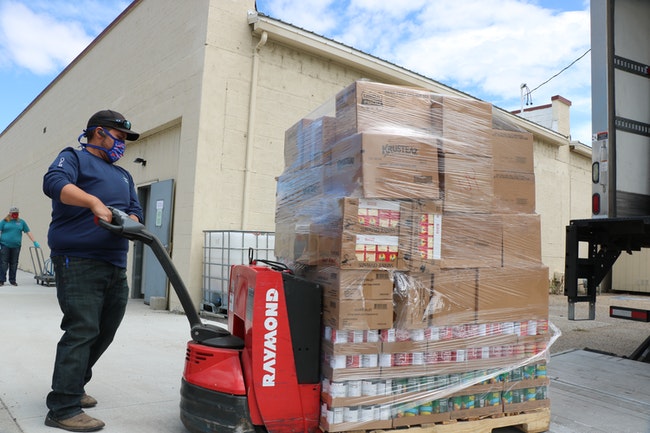 Juan Rodriguez, Oregon Food Bank warehouse specialist, delivers pallets of food to the Nyssa Food Pantry. (The Enterprise/FILE)
Juan Rodriguez, Oregon Food Bank warehouse specialist, delivers pallets of food to the Nyssa Food Pantry. (The Enterprise/FILE)
Oregonians and some state agencies are grappling with soaring food costs.
According to the U.S. Bureau of Labor Statistics, retail food prices have jumped 8.6% in a year, including a 1% uptick in February. Anyone who’s gone shopping has had sticker shock. Those who rely on public food benefits are especially vulnerable to rising prices.
The federal government increased the amount awarded to recipients of the Supplemental Nutrition Assistance Program, SNAP, in October, but not by much. School districts also have received some extra funding from the U.S. Department of Agriculture, which oversees school food programs.
But the state Department of Corrections, which spends $1.1 million a month on food, has not received any extra funding.
Officials have adjusted as best they can.
Higher fuel costs, rising freight charges and supply chain issues have driven up the cost of food over the past two years, officials said.
“Everything is driving the cost up,” said Ashley Mumm, public relations manager at the Oregon Food Bank.
A few examples: In October, a truckload of canned chicken cost $76,000. Now the price is $95,000, Mumm said. Last June, a truckload of vegetable oil cost $30,000. Now it’s $64,000.
The number of people seeking food aid also jumped dramatically once the pandemic hit. Normally, the Oregon Food Bank spends $1 million a month on food. But it had to spend more to meet demand.
“At the peak of a pandemic, we were spending upwards of $1 million a week on food purchases because of the disruptions to our regular food sourcing channels, coupled with the significant increase in demand for food assistance,” said Jason Stephany, the Oregon Food Bank’s communications director. “We witnessed unprecedented demand.”
The Oregon Food Bank received more than $14 million for food for the 2021-2023 budget cycle through the state Department of Human Services. A total of $12 million came from federal American Rescue Plan funds awarded during the pandemic. The food bank was also allocated an additional $8 million during the recent legislative session. It will use that money for food and to strengthen its infrastructure, including renovating some warehouses to make them more efficient.
Mumm said that the organization has been able to meet demand in part thanks to donors.
“We had 25,000 new donors last year,” Mumm said. “The community is definitely stepping up.”
Besides the Food Bank, which serves a network of 21 regional food banks that serve 1,400 food pantries and other programs, the other food assistance programs in Oregon are sponsored by the U.S. Department of Agriculture and administered by the state Department of Human Services.
Last fiscal year, from October 2020 through September 2021, the federal government gave Oregon $18 million for a program that provides food to families with incomes of no more than about $3,400 a month for an individual or nearly $7,000 a month for a family of four. The USDA also gave Oregon nearly $800,000 to provide monthly boxed allocations of food to those 60 and older.
Money from the federal government has been fairly stable, according to Jake Sunderland, press secretary for the Department of Human Services. He doesn’t expect it to rise in the future.
SNAP benefits increase
With the economy opening up and people going back to work, the number of households receiving government food aid has dropped – from more than 426,000 in January 2021 to nearly 378,000 a year later. Average aid per household rose, however, from about $240 a household in January 2021 to $280 in January 2022. Most of them received emergency food aid, which bumped up average household benefits from nearly $400 a month in January 2022 to nearly $465 a month.
The state has no ability to increase benefits more than that, according to Sunderland.
“The federal government has designed these food programs so that we can only provide what is approved by the federal government,” Sunderland said in an email. “It’s also important to acknowledge and understand that SNAP is designed by the federal government as a program to supplement a family or individual’s food budget. This means it is, by federal design, not enough to support an individual’s or family’s food needs.”
The agency doesn’t track food costs and has not acted to help low-income Oregonians cope with more recent inflationary food costs. But there is a federal program connected to SNAP that is administered through Oregon State University called SNAP Ed that offers classes in stretching food dollars.
“We try to help with teaching new strategies,” said Anne Hoisington, nutrition education coordinator for the program.
Specialists teach classes and demonstrate recipes in food pantries, shelters, senior centers and elsewhere, though the program shifted online during the pandemic. Hoisington said traffic to the program’s website, FoodHero.org, increased nearly 20% from September 2019 through June 2020.
The site offers tips to help stretch dollars, like buying in bulk when prices are lower and freezing portions. The current monthly newsletter has instructions on how to freeze vegetables by blanching them first. More tips: plan meals and shop with a list. The site lists dozens of low-cost recipes, including many designed to appeal to different ethnic and racial groups.
Department of Corrections changes menus
The Department of Corrections daily feeds about 12,000 inmates at 12 prisons across the state. The increase in prices has forced the agency to switch away from some higher-cost items. One example: Before the pandemic, it paid about $1.25 a pound for sliced roast beef. During the pandemic, supplies dropped and the price rose to more than $6 a pound.
“So we took it off the menu and replaced it with another type of sliced meat,” said Kent Fanger, the department’s food service administrator.
The department has some food contracts in place but they allow administrators flexibility to shop around as a consumer would. Fanger said that when chicken manufacturing plants started to close in the pandemic, he knew prices would skyrocket and chicken strips are a prison menustaple. So the department purchased enough to last almost a year.
“We ordered as much as we possibly could,” Fanger said, filling up the department’s warehouse in Salem.
The cost of getting food delivered has also pinched the department’s budget.
“Fuel costs have skyrocketed,” Fanger said. “Trucking companies are short drivers. If we’re getting a truck, it’s at a premium.”
The price of protein items remains high, and Fanger said the outlook on prices, with the ongoing war in Ukraine, is not good.
“I fully expect it to get worse,” Fanger said. “We actually have a bird flu epidemic that’s hitting the northeast.” An infected bald eagle was found dead earlier this month in British Columbia, the first along the Pacific since 2015.
If a poultry facility develops a case, they have to kill all of the birds.
“That’s going to drive the cost of eggs and the cost of chickens,” Fanger said.
School districts hit
The high cost of food has also affected school districts, child care centers and Head Start programs.
“Our schools are having challenges purchasing food for their programs,” said Dustin Melon, director of child nutrition programs at the state Department of Education.
There are 560,000 students in K-12 in Oregon, and many are eligible for breakfast and lunch. This school year, USDA, which funds school food programs, slightly increased the reimbursement rates per meal so schools could offer all meals for free.
“That indirectly has helped combat inflation because they’re getting a little bit extra in reimbursement for their meals but it wasn’t necessarily provided because of inflation,” said Melon. He said the higher reimbursement has not covered costs.
The USDA also granted Oregon $10.3 million this year to cover extra costs due to supply chain issues, which the Department of Education will be pass along to school districts.
The Beaverton School District, which has 39,000 students, expects to get $640,000, according to Charity Ralls, administrator for Beaverton’s nutrition services.
The USDA also granted waivers to districts to allow them to substitute less expensive items on their menus.
That’s forced administrators to analyze the cost of each item.
“For example, if we needed to serve a whole wheat cracker with our planned lunch, but the cracker was not available or shorted in our delivery, we may be able to serve pretzels instead,” Portland Public Schools said in a statement. The largest district in the state, it serves nearly 50,000 students.
Ralls said menu changes in the Beaverton district have led to decreased variety, but some items can’t be substituted.
“We are paying more for products that we need to serve meals,” Ralls said. “For example, paper boats to serve entrees have increased in price and are difficult to find. We have used alternate sources and purchased items locally or online.”
Administrators don’t expect much relief in the future.
“We expect greater increases across the board for next year,” Ralls said.
Schools have to keep their budgets in the black so if the price pressures continue they’ll have crimp elsewhere.
“The longer this goes on we’re going to see higher impacts on purchasing high-quality food, on staff, on their menus,” Melon said. “We could see a big impact for sure.”
Oregon Capital Chronicle is part of States Newsroom, a network of news bureaus supported by grants and a coalition of donors as a 501c(3) public charity. Oregon Capital Chronicle maintains editorial independence. Contact Editor Les Zaitz for questions: [email protected]. Follow Oregon Capital Chronicle on Facebook and Twitter.




